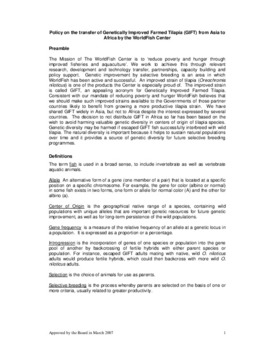Policy on the transfer of genetically improved Farm Tilapia (GIFT) from Asia to Africa by the WorldFish Center

Citation
The WorldFish Center (2007). Policy on the transfer of genetically improved Farm Tilapia (GIFT) from Asia to Africa by the WorldFish Center. WorldFish Center. 3 p.
The Mission of The WorldFish Center is to ‘reduce poverty and hunger through improved fisheries and aquaculture’. We work to achieve this through relevant research, development and technology transfer, partnerships, capacity building and policy support. Genetic improvement by selective breeding is an area in which WorldFish has been active and successful. An improved strain of tilapia (Oreochromis niloticus) is one of the products the Center is especially proud of. The improved strain is called GIFT, an appealing acronym for Genetically Improved Farmed Tilapia. Consistent with our mandate of reducing poverty and hunger WorldFish believes that we should make such improved strains available to the Governments of those partner countries likely to benefit from growing a more productive tilapia strain. We have shared GIFT widely in Asia, but not to Africa despite the interest expressed by several countries. The decision to not distribute GIFT in Africa so far has been based on the wish to avoid harming valuable genetic diversity in centers of origin of tilapia species. Genetic diversity may be harmed if escaped GIFT fish successfully interbreed with wild tilapia. The natural diversity is important because it helps to sustain natural populations over time and it provides a source of genetic diversity for future selective breeding programmes.
Permalink
Date Available
Type
Copyright
CC BY 4.0
Research Themes
Topics
Language